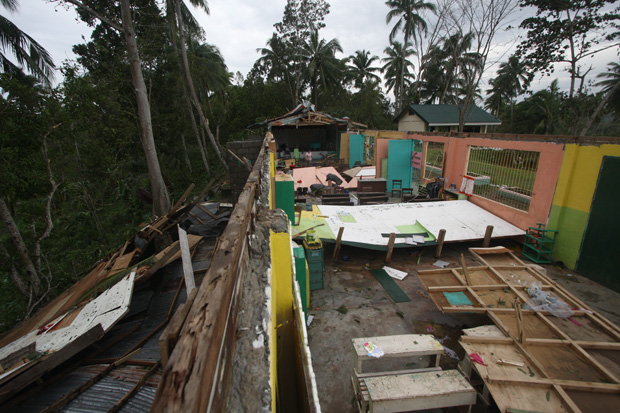DAVAO CITY (MindaNews/16 December) — Students in elementary and high school whose classrooms were destroyed by Typhoon Pablo on December 4 will be holding classes in tents, soon, the Department of Education’s Assistant Regional Director Nenita Lumaad, said.
 Strong winds brought by Typhoon Pablo blew away the entire roof of a three-classroom building of Mipangi Elementary School in Nabunturan, Compostela Valley province on 4 December 2012. Photo taken on December 5. Mindanews File Photo by Ruby Thursday More
Strong winds brought by Typhoon Pablo blew away the entire roof of a three-classroom building of Mipangi Elementary School in Nabunturan, Compostela Valley province on 4 December 2012. Photo taken on December 5. Mindanews File Photo by Ruby Thursday More
Lumaad told MindaNews that the UNICEF has donated 56 “learning space tents” which will be distributed to the worst hit areas in Compostela Valley and Davao Oriental.
The tents come with blackboards but does not include chairs, she said.
Lumaad told MindaNews that the DepEd will be purchasing 200 tents to serve as temporary classrooms by January.
Except for the worst hit towns in Compostela Valley and Davao Oriental, classes resumed on December 10 in the other towns of the two provinces and in the affected areas in Davao del Norte.
But the classes, she said, are just for three to four hours, including debriefing of students. It is important, she stressed, that students return to school. Christmas break begins December 21.
Lumaad said classes can also be held in the evacuation centers because parents usually leave the evacuation centers at daytime,
She said students in the worst hit towns of Compostela, New Bataan and Monkayo in Compostela Valley province and in the towns of Baganga, Cateel and Boston in Davao Oriental – will return to school – or the “learning space tents” — by January.
In schools where classes had resumed and classrooms were partially destroyed, teachers have been advised to hold classes in rooms or buildings used for non-academic purposes before Typhoon Pablo, such as feeding centers.
Mango trees gone, too
Lumaad said classes can’t be held under the shade of mango trees because in a number of schools, the mango and other shade trees were either uprooted or felled by the winds.
As of Friday afternoon, December 14,Lumaad could not provide a summary of the total number of school and classrooms destroyed by the typhoon in the region comprising the three Davao provinces and Compostela Valley because the reports were still being consolidated.
But the Division of Compostela’s report, which Lumaad showed to MindaNews, listed a total of 96 classrooms totally damaged, 300 classrooms need “replacement of roofing and ceiling totally damaged” and 144 classrooms require “repair of roofing/partition and ceiling/minor damages.”
She said the cost of constructing one classroom measuring 7 x 9 meters is P750,000, she said.
Lumaad, concurrent Schools Division superintendent of Compostela Valley province, was in the district office in Nabunturan when Pablo made landfall in Baganga, Davao Oriental.
She refered to Pablo s “very vicious.”
Lumaad said they lost three teachers in New Bataan town, one of them newly-married.
“You’d really feel depressed. At the click of a moment, dead,” said the 63-year old who experienced typhoon for the first time.
She said the winds were so strong by 3 a.m. she couldn’t see what was in front of her.
Candies, food for school
Lumaad said classes can also be held in the evacuation centers because parents usually leave the evacuation centers at daytime to repair their house or look for food.
She said some supervisors are doing creative ways to get the students from the evacuation centers or the roadside tents, back to school.
One bought candies to entice children to return to school, Lumaad said.
“We have to make schools enjoyable (so they will return), he said.
She said it would also help if the students receive school supplies or food packs to bring home ot to their families.
Lumad appealed to the Department of Public Works and Highways to “help us clean our rooms.”
In New Bataan, she said, there is a school whose classrooms can still be used but the mud is so thick inside and around the classrooms.
In Compostela town, Lumaad said they need water to clean up the classrooms while in Monkayo, they need chainsaws because of the felled or uprooted trees. (Carolyn O. Arguillas/MindaNews)
